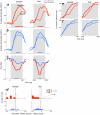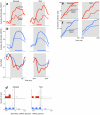Flexibility of sensory representations in prefrontal cortex depends on cell type
- PMID: 20005828
- PMCID: PMC2796258
- DOI: 10.1016/j.neuron.2009.11.018
Flexibility of sensory representations in prefrontal cortex depends on cell type
Abstract
Discrimination tasks require processing, interpreting, and linking sensory information to the appropriate motor response. We report that neurons in prefrontal cortex (PFC) represent visual motion with precision comparable to cortical neurons at early stages of motion processing, and readily adapt this representation to behavioral context. We found that direction selectivity, recorded while the monkeys discriminated directions, decreased when they judged motion speed and ignored its direction. This decrease was more pronounced in neurons classified as narrow-spiking (NS) putative interneurons than in broad-spiking (BS) putative pyramidal neurons. However, during passive fixation, when the link between motion and its behavioral relevance was removed, both cell types showed a severe selectivity loss. Our results show that flexible sensory representation during active discrimination tasks is achieved in the PFC by a specialized neuronal network of both NS neurons readily adjusting their selectivity to behavioral context, and BS neurons capable of maintaining relatively stable sensory representation.
Figures







Similar articles
-
Memory-guided sensory comparisons in the prefrontal cortex: contribution of putative pyramidal cells and interneurons.J Neurosci. 2012 Feb 22;32(8):2747-61. doi: 10.1523/JNEUROSCI.5135-11.2012. J Neurosci. 2012. PMID: 22357858 Free PMC article.
-
Common rules guide comparisons of speed and direction of motion in the dorsolateral prefrontal cortex.J Neurosci. 2013 Jan 16;33(3):972-86. doi: 10.1523/JNEUROSCI.4075-12.2013. J Neurosci. 2013. PMID: 23325236 Free PMC article.
-
Transitions between Multiband Oscillatory Patterns Characterize Memory-Guided Perceptual Decisions in Prefrontal Circuits.J Neurosci. 2016 Jan 13;36(2):489-505. doi: 10.1523/JNEUROSCI.3678-15.2016. J Neurosci. 2016. PMID: 26758840 Free PMC article.
-
Trial-to-trial variability of the prefrontal neurons reveals the nature of their engagement in a motion discrimination task.Proc Natl Acad Sci U S A. 2010 Dec 14;107(50):21842-7. doi: 10.1073/pnas.1009956107. Epub 2010 Nov 22. Proc Natl Acad Sci U S A. 2010. PMID: 21098286 Free PMC article.
-
Linking Neuronal Direction Selectivity to Perceptual Decisions About Visual Motion.Annu Rev Vis Sci. 2020 Sep 15;6:335-362. doi: 10.1146/annurev-vision-121219-081816. Annu Rev Vis Sci. 2020. PMID: 32936737 Review.
Cited by
-
Response Properties of Interneurons and Pyramidal Neurons in Macaque MSTd and VPS Areas During Self-Motion.Front Neural Circuits. 2018 Nov 23;12:105. doi: 10.3389/fncir.2018.00105. eCollection 2018. Front Neural Circuits. 2018. PMID: 30532695 Free PMC article.
-
The lateral prefrontal cortex of primates encodes stimulus colors and their behavioral relevance during a match-to-sample task.Sci Rep. 2020 Mar 6;10(1):4216. doi: 10.1038/s41598-020-61171-3. Sci Rep. 2020. PMID: 32144331 Free PMC article.
-
Non-linear dimensionality reduction on extracellular waveforms reveals cell type diversity in premotor cortex.Elife. 2021 Aug 6;10:e67490. doi: 10.7554/eLife.67490. Elife. 2021. PMID: 34355695 Free PMC article.
-
Single-cell coding of sensory, spatial and numerical magnitudes in primate prefrontal, premotor and cingulate motor cortices.Exp Brain Res. 2016 Jan;234(1):241-54. doi: 10.1007/s00221-015-4449-8. Epub 2015 Oct 5. Exp Brain Res. 2016. PMID: 26438509
-
Autocorrelation Structure in the Macaque Dorsolateral, But not Orbital or Polar, Prefrontal Cortex Predicts Response-Coding Strength in a Visually Cued Strategy Task.Cereb Cortex. 2019 Jan 1;29(1):230-241. doi: 10.1093/cercor/bhx321. Cereb Cortex. 2019. PMID: 29228110 Free PMC article.
References
-
- Asaad WF, Rainer G, Miller EK. Task-specific neural activity in the primate prefrontal cortex. Journal of Neurophysiology. 2000;84:451–459. - PubMed
-
- Barbas H. Anatomic organization of basoventral and mediodorsal visual recipient prefrontal regions in the rhesus monkey. Journal of Comparative Neurology. 1988;276:313–342. - PubMed
-
- Bartho P, Hirase H, Monconduit L, Zugaro M, Harris KD, Buzsaki G. Characterization of Neocortical Principal Cells and Interneurons by Network Interactions and Extracellular Features. J Neurophysiol. 2004;92:600–608. %R 10.1152/jn.01170.2003. - PubMed
Publication types
MeSH terms
Grants and funding
LinkOut - more resources
Full Text Sources
Other Literature Sources
Miscellaneous

